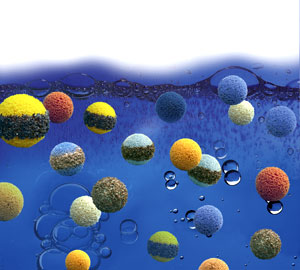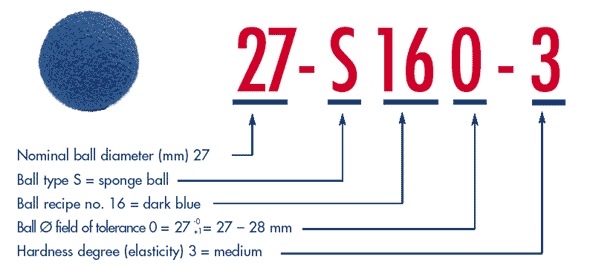Pure Efficiency
TAPROGGE cleaning balls form the process-technological basis of our tube cleaning systems. To yield the maximum benefit of a TAPROGGE system, it is important to select the adequate cleaning ball and its optimal operational mode. For every tube material, every type of cooling water and debris, as well as the plant-specific hydraulic conditions, place special demands upon the relevant ball. Our integrated service concept IN-TA-S® provides you with the safety always to work with the optimal cleaning ball. IN-TA-S® is based upon our knowhow in application technology, gathered by the operation of more than 10,000 TAPROGGE systems.
Efficiency in the Shape of a Ball
Support
IN-TA-S® centres in 10 regions the world over provide you throughout the year with all that is necessary for the right ball selection, its timely availability, and the optimized operation of a tube cleaning system. Special TAPROGGE programmes ensure the professional management of your requirement. The result: transparent evaluation of needs, stockpiling at favourable cost, as well as timely availability of the parts on site. Of course, you may also receive optimization support by remote monitoring and control of your systems from our IN-TA-S® Remote Centre. This is particularly fast and cost-saving.
Benefit
How much the right ball selection and continued optimization by TAPROGGE experts translates into thermal and financial benefits is shown by the following practical example: For a power station with 300 MW turbine capacity and 6,000 base load hours per year, a turbine efficiency gain of 1% and more can be reckoned with, which given an electricity price of 0.03 € per kWh - results in economies of 540,000 € per year. If, for reasons of faulty ball selection or insufficient ball optimization, the efficiency gain is only 0.9%, the annual economy is only 486,000 € - which is by 54,000 € less than in case of optimal recommendation. Conclusion: the optimal ball selection magnifies the benefit to millions (based on the total lifetime of the power station).
Interesting Facts around the Cleaning Ball
Ball Selection and Optimization
For the determination of the type of cleaning ball and the mode of operation, TAPROGGE uses special in-house software that reflects the application experience of meanwhile more than 5,000 TAPROGGE cleaning systems. Essential parameters of calculation are: tube material, tube geometry, water velocity and temperature, water biology and chemistry, as well as hydraulic and design data of the installed system. If necessary, those calculating instruments are complemented by the special, additional IN-TA-S® modules:
- diagnostics on site (condenser inspection and ball distribution tests)
- diagnostics in the TAPROGGE Technological Centre (tube examination)
- consultancy in application engineering (with solutions to special questions of fouling, scaling, and corrosion), and performance of client-specific schemes (abrasive ball cleaning, ferrous sulfate dosing, monitoring of cooling tube conditions).
Available Range of Cleaning Balls
TAPROGGE’s standard range of products includes balls in diameters from 14 - 44 mm. Approx. 6 million cleaning balls are permanently ready for delivery. Other sizes can be supplied on request.
Ball Types and Tube Material
The different tube materials tend to typical appearances of fouling, scaling and corrosion. The ball types respond to those appearances by their recipes and coatings. The following assignments are usually made:
- for CuNi and brass tubes:
- P150 (standard), S160 respectively. To optimize the ball distribution: addition of 50 % P130
- L160 and PL130 for prolongation of ball lifetime
- P150 / PL150 with rough tubes
- for tubes of stainless steel and titanium:
- P150, G160 resp. - short-term application of T160 / T300
- for seawater desalination plants:
- Heat-resistant balls S200 and S220
- for air conditioning plants:
- irrespective of tube material: S110
Nominal Ball Diameter
The nominal ball diameter depends on the inner tube diameter and the cooling water velocity within the tubes. The nominal ball diameter exceeds the inner tube diameter by 1 to 3 mm.
Ball Hardness Degree
The degree of hardness of the cleaning ball is determined in dependence on the water velocity in the tube, the gap width of the strainer section, and the screen angle.
Cleaning Frequency
Proven successful with stainless steel and titanium tubes has an average cleaning frequency of 12 cleaning balls per hour and tube. Detailed, basic recommendations for the specific ball types are given on the following
Interesting Facts around the Cleaning Ball
Ball Distribution
The distribution of the cleaning balls and thus the cleaning frequency of the individual cooling tubes are influenced by the ball distribution in the cooling water inlet pipe, the flow conditions in the waterboxes and especially by the properties of the TAPROGGE balls adapted to those parameters. Through mixtures of different ball types with adjusted sinking velocity the distribution is optimized even further.
Ball Lifetime
Essential factors of influence for the ball life are: tube roughness, degree of fouling of the tubes, as well as type of fouling. That is why the degree of wear of a cleaning ball fluctuates between a few days and approx. 4 weeks, depending on tube condition.
Ball Nomenclature (Example)
Ball type (sponge rubber ball)
| Code | Type |
| G | plastic granulate ball |
| L | long life ball |
| P | polishing ball (standard ball) |
| R | ring-coated corundum ball |
| S | sponge ball |
| T | totally coated corundum ball |
Hardness degree (elasticity)
| Code | hardness degree | special hint |
| 1 | soft | |
| 2 | soft/normal | special balls |
| 3 | normal | |
| 4 | normal/hard | special balls |
| 5 | hard | |
| 6 | extra hard | special balls |
TAPROGGE Cleaning Balls for all Types of Cooling Water with Temperatures of up to 80°C
| Application | Frequency | Special Features | |
|---|---|---|---|
|
for all tube materials, especially with heat exchangers of air conditioning plants |
as per case-specific recommendation |
TAPROGGE Cleaning Balls for all Types of Cooling Water and Brine with Temperatures between 80°C and 120°C.
| Application | Frequency | Special Features | |
|---|---|---|---|
|
see S200 |
see S200 |
Sinking velocity is lower than T300 and S200 balls |


















